B0041VYHGW EBOK (54 page)
Authors: David Bordwell,Kristin Thompson

4.94 The president pauses and rubs his fingers together thoughtfully …

4.95 … then he taps into the intercom with his right hand.
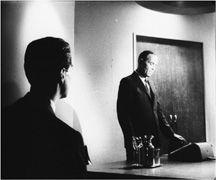
4.96 As he waits, for a brief moment his left fingers waggle anxiously.
Whether more or less typed, the performance can also be located on a continuum of stylization. A long tradition of film acting strives for a resemblance to what is thought of as realistic behavior. This sense of realism may be created by giving the actors small bits of business to perform while they speak their lines. Frequent gestures and movements by the actors add plausibility to the humor of Woody Allen’s films
(
4.99
).
More intense and explicit emotions dominate
Winchester 73,
in which James Stewart plays a man driven by a desire for revenge
(
4.100
).
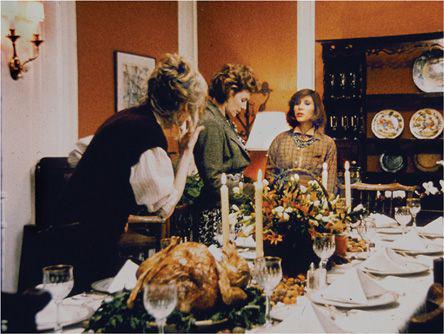
4.99 Verisimilitude in acting: Mia Farrow as Hannah, Diane Wiest as her sister Holly, and Carrie Fisher as their friend April set a table, chatting about the other guests in
Hannah and Her Sisters.

4.100 In
Winchester 73,
Jimmy Stewart’s mild manner occasionally erupts into explosions of anger, revealing him as on the brink of psychosis.
Psychological motivation is less important in a film like
Trouble in Paradise,
a sophisticated comedy of manners in which the main concern is with more stereotypical characters in a comic situation. In
4.101
, two women competing for the same man pretend to be friendly. Again, the performances are perfectly appropriate to the genre, narrative, and overall style of the film.

4.101 The exaggerated smiles and gestures in
Trouble in Paradise
are amusing because we know that each woman is trying to deceive the other.
Comedy doesn’t provide the only motivation for greater stylization.
Ivan the Terrible
is a film that heightens every element—music, costume, setting—to create a larger-than-life portrait of its hero. Nikolai Cherkasov’s broad, abrupt gestures fit in perfectly with all of these other elements to create an overall unity of composition
(
4.102
).
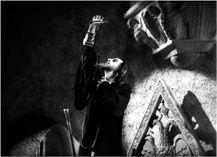
4.102 Nikolai Cherkasov’s dramatically raised arm and thrown-back head are appropriate to the heightened style of
Ivan the Terrible.
CONNECT TO THE BLOG
Sometimes critics concentrate on acting to the exclusion of a film’s other qualities, as we complain in “Good actors spell good acting.”
See
www.davidbordwell.net/blog/?p=146
.
For the conventions of award-winning performances, see “Good actors spell good acting, 2: Oscar bait,” at
www.davidbordwell.net/blog/?p=205
.
Some films may combine different degrees of stylization.
Amadeus
contrasts a grotesque, giggling performance by Tom Hulce as Mozart with Murray Abraham’s suave Salieri. Here the acting sharpens the contrast between the older composer’s decorous but dull music and the young man’s irrepressible but offensive genius.
Films like
Caligari, Ivan the Terrible,
and
Amadeus
create stylized performances through extroversion and exaggeration. The director can also explore the possibilities of very muted performances. Compared to normal practice, highly restrained acting can seem quite stylized. Robert Bresson is noted for such restrained performances. Using nonprofessional actors and drilling them in the details of the characters’ physical actions, Bresson makes his actors quite inexpressive by conventional standards
(
4.103
,
4.104
).
Although these performances may upset our expectations, we soon realize that such restraint focuses our attention on details of action we never notice in most movies.

4.103 Playing the heroine of
Au Hasard Balthasar,
Anna Wiazemsky looks without expression at her would-be seducer, who wants her to get in his car …
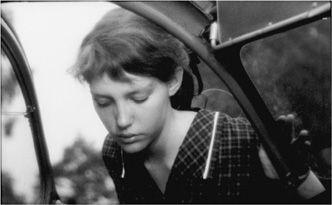
4.104 … and glances downward, still without registering her thoughts, before getting into the car.
By examining how an actor’s performance functions in the context of the overall film, we can also notice how acting cooperates with other film techniques. For instance, the actor is always a graphic element in the film, but some films underline this fact. In
The Cabinet of Dr. Caligari,
Conrad Veidt’s dancelike portrayal of the somnambulist Cesare makes him blend in with the graphic elements of the setting
(
4.105
).
As we shall see in our examination of the history of film styles, the graphic design of this scene in
Caligari
typifies the systematic distortion characteristic of German Expressionism.
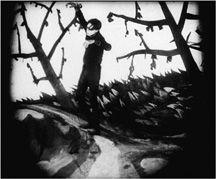
4.105 In
The Cabinet of Dr. Caligari,
Cesare’s body echoes the tilted tree trunks, his arms and hands their branches and leaves.
